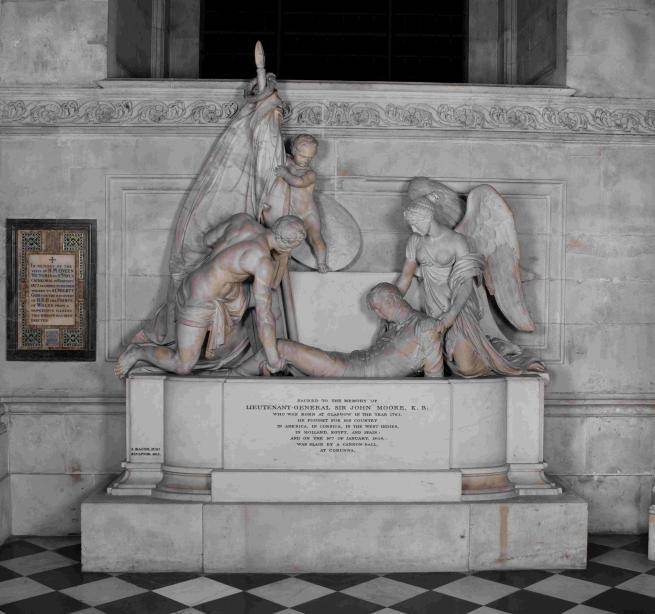John Moore

Image courtesy of Pantheons – Sculpture at St Paul's Cathedral (c.1796–1916) (york.ac.uk)
John Moore
1761-1809
Part of War and resistance in the Caribbean: The monuments at St Paul's: A digital trail produced in collaboration with SV2G.
The following entry has been researched and written in collaboration with members of SV2G.
Note: We are only at the start of the journey toward centring the Caribbean voice in the Revolutionary Wars. The campaigns have traditionally been documented without a focus on the impact on local populations. Although the archival records offer limited information and this area of historical study is under-developed, our project raises awareness about the activities of the British campaigns in the Caribbean and their lasting legacies, and introduces visitors to a number of Caribbean heroes.

In April of 1796, British forces invaded the island of Saint Lucia which had been held by French revolutionaries since June 1795. A month later, the French garrison holding Fort Charlotte on Saint Lucia surrendered to British forces commanded by Lieutenant General John Moore. In the terms of surrender, Gaspard Goyrand (the French governor of Saint Lucia who had abolished slavery on the island) pleaded with the victorious British to protect ‘people of every age, of every sex, of every colour’ under a universal law. The British bluntly rejected this, declaring instead, ‘All property, all inhabitants shall be under the dependence and protection of English laws’: in other words, race-based slavery would be restored. Previously, Goyrand had called the re-enslaving of soldiers on other islands a ‘manifest violation of human rights’.
However, the British did agree to treat all captured soldiers, regardless of colour, as prisoners of war rather than slaves. Over 2,500 prisoners of war were captured by the British in St. Lucia, St. Vincent and Grenada and were transported to Portchester Castle on the south coast of England in October 1796, but not everyone survived the journey. On board were over 2,000 black soldiers and over 300 white soldiers, as well as 99 women and children, mainly of colour.
Those Caribbean prisoners that survived at Portchester were eventually exchanged for captured British soldiers. Many were sent to France, and others were recruited into the British Navy and Army. In France, the black soldiers were prevented from integrating into French European regiments. The prejudice against them was evident in a decree of 22 May 1798: any black soldiers and their families who had returned to France from the colonies or from English prisons would have to be exiled to Île-d’Aix, a remote setting off the west coast of France where food was scarce with very few rations and poor sleeping conditions. Many also had their pay reduced and struggled to live. They were prevented from travelling to the mainland to buy food. These soldiers formed a unit and called themselves the ‘Battalion des Pionniers Noirs’ (the Battalion of Black Pioneers). In 1805 when France had seized Naples, this battalion was sent to Italy to provide military support. They became known as the 7th Royal African Regiment (‘Royal’ because they were under the flag of the Kingdom of Naples) and fought in Russia and Italy.
In the aftermath of the British invasion of Saint Lucia in May 1796, John Moore was promoted to Military Governor of Saint Lucia and tasked with bringing order and subduing a group of freedom fighters known as the Brigands who had not surrendered or been captured when the British conquered the island. Many of them were maroons (self-liberated formerly enslaved people) and were highly skilled warriors who were deeply connected to their environment, resourceful in their tactics, and resilient in the face of adversity. Their deep knowledge of the island's rugged terrain, coupled with rapid, elusive strikes, exemplified warfare that Moore himself acknowledged for its effectiveness. This allowed them to evade detection in the dense forests and launch surprise attacks on British outposts.
Among their ranks stood Flore Bois Gaillard, an enslaved mixed-race woman who escaped to the woods where she met the Brigands and quickly became their leader. Although contemporaneous sources about Flore Bois Gaillard are scarce, with much of her story preserved through local memory and oral traditions, her legacy as a leader and fighter is unequivocally celebrated. She embodies the strength, bravery and resistance of women fighters, serving as a powerful reminder of their contribution to the Caribbean's historical struggles against oppression.
Moore and his forces experienced notable defeats and his reflections on the conflict reveal a grudging respect for his adversaries. In June 1797 he contracted a severe case of yellow fever and was sent back to England.
The spirit of resistance continued in Saint Lucia with reports in 1797 of formerly enslaved, runaway persons living autonomously in the woods and causing problems for British troops. Despite living under the constant threat of detection, they still made the decision to stay away rather than face a lifetime of servitude on the plantations.

Rendering of the ‘Bataillon des Pionniers Noirs’, initially comprising Caribbean prisoners-of-war, who eventually became known as the 7th Royal African Regiment. Image source: public domain.


Above two images: Fond Gens Libre (Village/Valley of the Free People) at the base of Gros Piton to which enslaved people escaped and where Flore Bois Guillard and the Brigands fought. Image source: public domain.
Listen to an audio-recording of this text read by a member of SV2G. Sound recording by Marlon Lewis, Life in Frames.
For detailed information about this monument, visit the Pantheons: Sculpture at St Paul's Cathedral website.

War and resistance in the Caribbean
The monuments at St Paul's
Explore the full digital trail produced in collaboration with SV2G.




